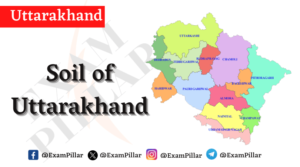According to the study report, soil erosion was highest in the disaster that occurred in Uttarakhand in 2013. The incidents of cloud bursts have been increasing in the hilly areas of the state since last few years, which is giving rise to incidents of soil erosion. According to the data prepared in 2017, there is 24295 square kilometers of forest area in the state, which is 45.43 percent of the total area of the state. Considering the land structure of Uttarakhand, The land is divided into three parts. Which is as follows –
Soil in Uttarakhand
1. Land of Pond/River valley
- In Uttarakhand, rivers create vast fertilizer plains along their course.
- Irrigation facility is also available in these plains. Due to the fertile soil, wheat and paddy are cultivated here.
- This is a state with medium agricultural sector. And the irrigated land in Uttarakhand is called Kotlav.
2. Land of plains
- This includes the entire Terai Bhabar region. Which includes some parts of Dehradun, Haridwar, Udham Singh Nagar and Nainital.
- There is a flat and fertile plain here. And agriculture is found in the most developed state in these plains.
- In these areas, wheat, paddy, sugarcane and pulses crops are produced more.
3. Land with mountain slopes / uprooted
- Terrace farming is done on the mountains in Uttarakhand.
- Due to lack of irrigated land, it is called Ukhad in the local language. This agriculture is based on rain.
- Due to which production is less and uncontrolled. Therefore, at present people have left agricultural activities and engaged in other professions.
- ICAR (Indian Council of Agricultural Research, Delhi) has called the soil of Uttarakhand as mountain or forest soil.
On the basis of soil composition, following types of soils are found in Uttarakhand –
1. Terai soil
- In the southernmost part of the state, from the southern tip of Dehradun to Udham Singh Nagar, Terai soils are found formed by the deposits of fine particles.
- Compared to other soils of the state, it is more mature and deficient in Nitrogen and Phosphorus.
- This soil is flat, marshy, moist and fertile.
- Sugarcane and paddy production is good in this area.
2. Bhabar soil
- Bhabar Soil is found north of Terai and south of Shivalik.
- Being formed from heavy deposits of Himalayan rivers, this soil is made up of pebbles, stones and coarse sand.
- The soil here is rocky and full of pebbles, due to which water goes down.
- This soil is unsuitable for agriculture.
- Due to lack of water it is infertile.
3. Pasture Soil
- Such soils are found in low lying areas near water streams and in the coastal areas of rivers and other water flows.
- This soil can be divided into the following five parts –
- Matiyar Loam (brown color, more Nitrogen and organic matter and less lime)
- Highly Calcareous Loam
- Low Calcareous Loam
- Non Calcareous Loam
- Sandy Loam
4. Tertiary soil
- This soil is found in Shivalik hills and Doon valleys which is light, sandy and porous i.e. it holds less moisture.
- The quantity of vegetation and organic matter is less in it. But the soil of Doon Valley has more vegetation content and more capacity to hold moisture as compared to other areas.
- It is found in Shivalik and Doon valley.
5. Quartz Soil
- This soil is found in Bhimtal area of Nainital.
- It has been formed by the splitting of rocks like schist, shale, quartz etc. formed in the Cretaceous era of Proto, Paleo and Middle Kalpa.
- This soil is light and infertile.
- It is called quartz soil.
6. Volcanic Soil
- This soil is found in Bhimtal area of Nainital district.
- This soil, formed by the splitting of igneous rocks, is light and sandy and is suitable for agriculture.
- This type of soil is called volcanic soil.
7. Loamy soil
- Easily available in the lower slopes of the Shivalik Hills and the Doon Valley, this soil is slightly greasy and contains lime, iron particles and organic matter.
- Loamy soil is found in Doon Valley.
- It contains abundance of Lime and Iron content.
8. Brown Red Yellow Soil
- This soil made of lime and sandstone, shale and dolomite rocks is found near Nainital, Mansoori and Chakrauta.
- Its color is brown, red or yellow.
- This happens with surface rocks and botanical remains.
- This soil is more moisture sensitive and fertile.
9. Red soil
- This soil is mostly found on the slopes of mountains or on the sides of mountains.
- This soil is unorganized.
10. Brown soil of forests
- Brown soil of forest is found in most of the forest parts of Uttarakhand.
- It has abundance of organic elements and deficiency of lime and phosphorus.
11. Ashy soil
- This soil is found in less sloping places, areas of mountain ranges and sub-tropical and temperate areas.
12. Highest mountain shallow soil
- This soil is found in high hilly areas with less rainfall.
- Due to extreme dryness and lack of vegetation it is completely immature.
- Its layer is thin.
13. High Plains Soil
- This soil is generally found at an altitude of more than 4000 km.
- Due to the effect of dry climate, wind weathering and glacial erosion, there is often lack of moisture in these soils.
- It is mildly alkaline and contains high amounts of organic matter.
- Due to the mixture of rock fragments and other polluted substances, there is variation in the formation and structure of this soil.
- These are also called alpine pastures soils.
| Read Also : |
|
|---|---|
| Uttarakhand Study Material in Hindi Language (हिंदी भाषा में) | Click Here |
| Uttarakhand Study Material in English Language |
Click Here |
| Uttarakhand Study Material One Liner in Hindi Language |
Click Here |
| Uttarakhand UKPSC Previous Year Exam Paper | Click Here |
| Uttarakhand UKSSSC Previous Year Exam Paper | Click Here |





Leave a Reply